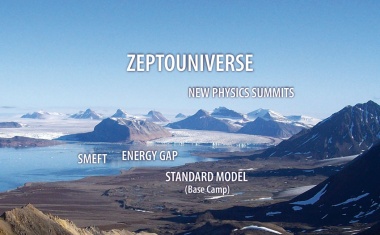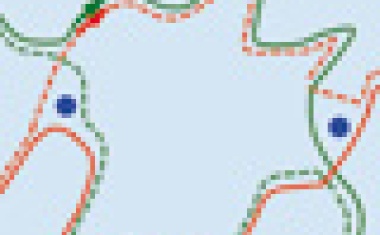 Andrzej J. Buras • 9/2020 • Seite 32 • DPG-Mitglieder
Andrzej J. Buras • 9/2020 • Seite 32 • DPG-MitgliederExpedition to the Zeptouniverse
Flavour experiments promise insights into energy scales as high as 200 TeV and distances as small as 10−21 meter and offer the chance to identify New Physics.
The Large Hadron Collider (LHC) at CERN will directly probe distance scales as short as 10–19 m, corresponding to energy scales at the level of a few TeV. Presently, higher resolution can only be achieved with the help of quantum fluctuations caused by new particles and new forces that act at very short distance scales and modify the predictions of the Standard Model of particle physics for very rare processes. In this context, weak decays of mesons and leptons play the prominent role besides the transitions between particles and antiparticles in which flavours of quarks and leptons are changed. In this manner, information about the Zeptouniverse corresponding to energy scales as high as 200 TeV or distances as small as 10–21 m can be obtained.
The year 1676 was very important for humanity, because Antoni van Leeuwenhoek discovered the empire of bacteria. He called these small creatures animalcula (small animals). His discovery was a milestone in our civilization for at least two reasons: He discovered creatures invisible to us which have been killing humans for thousands of years, often responsible for millions of deaths in one year. While Antoni van Leeuwenhoek did not know that bacteria could be dangerous for humans, his followers like Louis Pasteur, Robert Koch and other „microbe hunters“ realized the danger coming from these tiny creatures and also developed weapons against this empire [1].
Van Leeuwenhoek was the first human who looked at short distance scales invisible to us and discovered thereby a new underground world. At that time, researchers looked mainly at large distances, discovering new planets and finding laws, such as the Kepler laws which Isaac Newton was able to derive from his mechanics. (...)
 Martin R. Zirnbauer • 9/2012 • Seite 41
Martin R. Zirnbauer • 9/2012 • Seite 41Of symmetries, symmetry classes, and symmetric spaces
From disorder and quantum chaos to topological insulators
Quantum mechanical systems with some degree of complexity due to multiple scattering behave as if their Hamiltonians were random matrices. Such behavior, while originally surmised for the interacting many-body system of highly excited atomic nuclei, was later discovered in a variety of situations including single-particle systems with disorder or chaos. A fascinating theme in this context is the emergence of universal laws for the fluctuations of energy spectra and transport observables. After an introduction to the basic phenomenology, the talk highlights the role of symmetries for universality, in particular the correspondence between symmetry classes and symmetric spaces that led to a classification scheme dubbed the “Tenfold Way”. Perhaps surprisingly, the same scheme has turned out to organize also the world of topological insulators.
Let me begin by expressing that I feel greatly honored to be this year’s recipient of the Max-Planck medal, and I appreciate the opportunity to give a talk on some of the work that may have earned me this distinction. To set the stage and give you a flavor of what is to come, let me remind you of the old but still fascinating story of universal conductance fluctuations (UCF). Predicted theoretically in the middle of the 1980s by Altshuler [1] and by Lee and Stone [2], UCF was investigated in a large number of experiments. It was found that in a great variety of different mesoscopic systems − such as a small gold ring for example, or an even smaller silicon MOSFET − the electrical conductance displays characteristic fluctuations of the order of one when expressed in units of the conductance quantum e2/h (Fig. 1). What is most remarkable is that the size of the fluctuations in a broad range of parameters does not depend on the system dimension, the disorder strength, etc., but only on a few fundamental symmetries.
It was realized early on that there exists a close connection with the fluctuations that had been observed decades earlier in the scattering cross section of slow neutrons on atomic nuclei. This far reaching connection is at the very root of what I have to say. It led, among other things, to the development of a broad framework in which to model and calculate mesoscopic effects such as UCF. ...
 • 9/2020 • Seite 32 • DPG-Mitglieder
• 9/2020 • Seite 32 • DPG-Mitglieder

